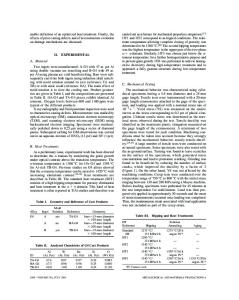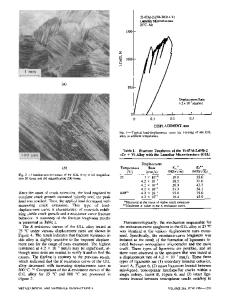Influence of microstructure on crack-tip micromechanics and fracture behaviors of a two-phase TiAl alloy
- PDF / 6,277,362 Bytes
- 15 Pages / 612 x 792 pts (letter) Page_size
- 100 Downloads / 300 Views
I.
INTRODUCTION
T I T A N I U M aluminide alloys based on gamma TiAI are of interest as a potentially important aerospace structural material because of their light weight, relatively good high-temperature mechanical properties, and oxidation resistance.[~ 41 Unfortunately, neither the ductility nor the fracture toughness of these TiAl-alloys is particularly high at ambient temperature. Coupled with poor formability, the TiAl-alloys are still far from being fully utilized in aerospace applications. With alloy modification and microstructure control, however, both ductility t3"5] and toughness [5'6] have been improved significantly in twophase g a m m a titanium aluminide alloys during the last couple of years, although these alloys are still not adequate for application. Advanced two-phase TiAl-alloys generally consist of Ti-(46 to 49) at. pct AI-(2 to 5) at. pct M, M being at least one element from V, Cr, Mn, and Nb, with occasionally W o r Mo. [3'7-101 In the as-cast conditions, 13"~tl or when heat-treated in the a phase f i e l d , 13"6'7't21 the twophase TiAl-alloys exhibit a lamellar microstructure consisting of alternating layers of ordered 3' (L10 structure) and a2 (D0~9 structure) platelets. Duplex microstructures consisting of equiaxed gamma grains with small amounts of alpha-2 in plate or particulate forms can be formed when heat treated in the ( a + 3') phase f i e l d . 13'6"7'131 Both the amount of alpha2 phase and the relative volume fraction of lamellar and equiaxed 3' grains are important factors controlling the fracture properties of two-phase TiAl-alloys. 12,4.8] Maximum tensile ductility was obtained in a two-phase TiAl-alloy containing approximately 10 K.S. CHAN, Principal Engineer, is with the Department of Materials and Mechanics, Southwest Research Institute, San Antonio. TX, 782385166. Y.-W. KIM. Group Leader, is with the Metcut-Materials Research Group, Wright-Patterson AFB, OH 45433-0511. Manuscript submitted September 3. 1991. METALLURGICAL TRANSACTIONS A
w)l pct of the o~2 phase. Isj The best balance of properties with good elevated-temperature creep resistance and acceptable tensile strength and ductility in current two-phase TiAl-alloys appears to occur at about 30 vol pet of lamellar grains and 70 vol pct equiaxed grains, t3,7,~4] While these previous results clearly indicate the beneficial effects of the lamellar microstructure, the mechanisms by which the aligned microstructure imparts fracture toughness and tensile ductility remain unclear. It has been suggested that the lamellar microstructure enhances the ductility in Ti-48AI by inducing fine, uniform deformation of 3' plates in the early stage of deformation and then o~2 plates in the latter stage/91 The activation of twinning in the lamellar microstructure may also be an important, beneficial factor for improving the fracture characteristics of the two-phase 3' alloy, ttj The objective of this article is to present the results of an investigation aimed at studying the effect of microstructure on the fracture processes and cr
Data Loading...











